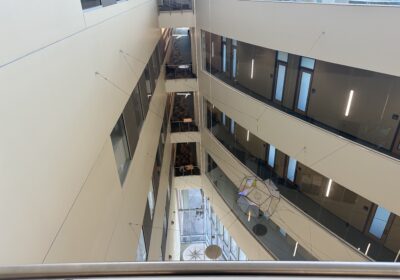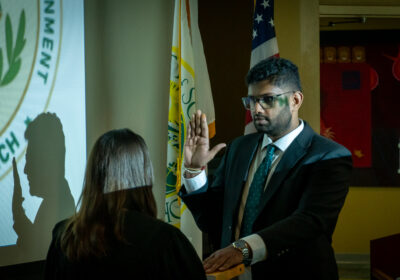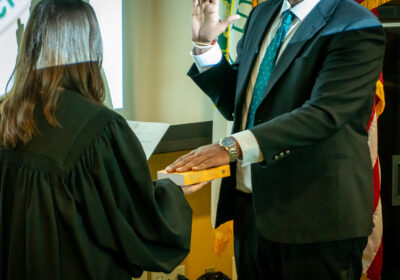Less typing, more writing

Depending on a student’s interest in a teacher’s lecture, laptops are a tool for transcription or a distraction. Since teachers can’t see whether a student is taking notes or typing jokes on social media, some instructors ban laptops with the goal of removing the opportunity for diversion.
Now, however, the motivation for banning laptops in class is changing.
Some USF professors are applying research from Princeton University that shows taking handwritten notes, as opposed to a computer, likely increases a student’s capacity to absorb and think critically about the information they are learning.
Jameson Hayes, an advertising professor, is one such teacher who has banned laptops this semester in all of his undergraduate classes.
“I need students to be able to think critically and problem solve,” he said. “If students are in the classroom taking notes, while they may take more notes, they tend to take down the lecture verbatim instead of processing it.”
In the Princeton study, researchers tested two groups of 67 students on retention and comprehension after taking notes in a classroom. Though the group that used a computer wrote more words, the students who took notes by hand digested the information better.
The higher learning attributed to handwritten notes, according to a Scientific American article, is attributed to different modes of cognitive processing.
“Taking notes by hand forces the brain to engage in some heavy mental lifting,” the article stated. “Faster typing speeds allow students to transcribe a lecture word for word without devoting much thought to the content.”
Hayes said he noticed that some of his students in previous semester were only learning the definitions and parroting back the answers when it came time to take the test.
“If I said, ‘what’s the definition of this?’ then a student may be able to tell me what I said in class, but they can’t explain or apply that concept,” he said. “(A teacher) needs to ask ‘how do you explain this concept?’”
Not every student would be happy if his or her laptops are taken away, like Cassandra Clermont, a sophomore majoring in business finance, and Kiana Burns, a junior majoring in international studies.
“A laptop is something that is essential in the 21st century, especially if you do not have the textbook with you in class,” Clermont said.
“I have an acting class in which technology is prohibited so that we are able to meet and interact with other students,” Burns said. “However, in a lecture class where the teacher speaks very fast, I would understand why it would be easier to use a laptop.”
However, some students wouldn’t mind taking class notes by hand, such as Paige Kieffer, a junior majoring in health science.
“Typing is simply a routine for me,” Kieffer said. “But handwriting actually helps me to read and remember what I learned.”
When Hayes implemented a policy to disallow laptops at the start of this semester, he said his students were fine with the policy and understood his reasoning.
Though it’s only two weeks into the semester, he said he’s noticed improved engagement in the classroom. However, he said there are some downsides.
“They could be Googling to expand on what I’m saying, but I found that students engage more and internalize the information if the computer is not there,” he said.
The millennial generation is the first generation to grow up with the Internet and therefore has always had easy access to far more information than any other generation.
Another problem is whether immediate access to answers hinders students from trying to solve questions themselves, as if the Internet is a collective brain doing all the work instead of the individual.
“This generation knows how to go out and find content better than any generation before,” he said. “But if they don’t understand the topic conceptually, then all they do is take the word from whoever they got it from online, as opposed to thinking through what is said and making their own judgments.”
Much of this reliance on expecting questions that can be answered with either “true or false” or “multiple choice” comes from the education system’s overreliance on standardized testing, Hayes said, with too much emphasis on answering questions and not enough on asking questions.
“You can multiple choice that word for word, but you don’t understand the concept and how to apply it,” he said. “You tend to lose some of that problem-solving ability.”
To Hayes, an ideal classroom is one with back-and-forth discussion where students asks questions and challenge the teacher. This is harder to do when students are huddled behind laptops.
This type of environment teaches students to learn how to think, Hayes said — an intangible skill that cannot be easily graded.
“When you get to the real world, it’s not going to be a rubric world,” he said. “A boss may give you some guidance, but they’re going to expect you to be able to think.”
Though closing the laptop and taking handwritten notes is a good step to fostering this type of higher-conceptual learning, Hayes said it then falls to the teacher to ask questions on tests that have the student apply those concepts, such as asking students to write essays instead of filling in the blank.
“That’s what separates a high school diploma from a college diploma,” he said. “(A college graduate) is built to go out and create a career and run companies rather than simply being a lower level employee in those companies.”






